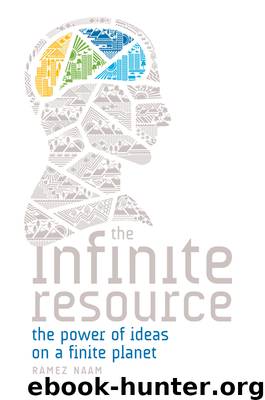The Infinite Resource by Naam Ramez

Author:Naam, Ramez
Language: eng
Format: epub, mobi
Publisher: University Press of New England
Increasing our governmental investments in R&D, introducing competition and incentives into schooling, and funneling more college students into science and engineering are all key steps to boosting our long-term rate of innovation. Yet there’s something else we have to do on top of that. We have to address the limitations and flaws of the market itself. And that is where the next two chapters will take us.
fourteen the flaw
in the market
“To get rich is glorious.” With these words, Deng Xiaoping, premier of China, leader of the most populous Communist nation on Earth, ushered in the global capitalist era.
In 1976, Mao Tse-tung, who’d exiled Deng for his pragmatism and openness to Western economic ideas, died, opening the door for the reformist Deng’s rise to power. Deng returned from his exile to Beijing’s halls of power in 1977 and seized the reins of China just a year later.
Deng Xiaoping’s first actions after being restored to the leadership of China were remarkable departures from China’s Communist past. In 1977, he successfully pushed to allow Chinese capitalists to join the Communist Party. In 1978, he opened China to foreign corporations, purchasing aircraft from Boeing and allowing Coca Cola to begin selling its products in the country. In 1979 he began to unravel the system of communal farming in China. He lowered minimum quotas on Chinese farmers, gave them more control over what was planted, and allowed them to keep whatever profits they could garner from selling any production above and beyond their quota. In the next few years he would open China to foreign investments, create incentives for local managers based on the success of their state-run operations, and allow private businesses to operate for the first time since the Communists had taken over the country in 1949.1
Deng’s rise to power and his reforms, in a manner rather unnoticed by the West, heralded the end of the era of state-run economies and the final phase of capitalism’s takeover of world economies. Eleven years after Deng’s reforms in China, Mikhail Gorbachev’s attempts at political reforms in the USSR would lead to its disintegration and the end of the richest state-run economy on the planet. Two years later, in 1991, a nearly bankrupt India, in a move of desperation, dramatically loosened economic controls, allowed foreign companies in, and embraced capitalism. In those short thirteen years, more than a third of humanity would go from living in a state-run economy to living in a market-driven economy.
Markets drive more of what happens around the world today than governments do. Virtually all of the world’s $73 trillion in economic activity goes through markets of some sort. By contrast, the world’s governments spend around $25 trillion a year. And much of that they spend by buying goods and services on the open market.
Nor is this a bad thing. In fact, in almost every case, the arrival of markets—when coupled with property rights, the rule of law, and good governance—has led to massive reductions in poverty and increases in living standards.
In 1978 China had an estimated 270 million people living in poverty.
Download
This site does not store any files on its server. We only index and link to content provided by other sites. Please contact the content providers to delete copyright contents if any and email us, we'll remove relevant links or contents immediately.
| Acoustics | Bridges |
| Earthwork Design | Environmental |
| Fire Science | Highway & Traffic |
| Hydrology | Remote Sensing |
| Seismic Design | Structural |
| Structural Dynamics | Surveying & Photogrammetry |
| Transportation |
Whiskies Galore by Ian Buxton(41879)
Introduction to Aircraft Design (Cambridge Aerospace Series) by John P. Fielding(33064)
Small Unmanned Fixed-wing Aircraft Design by Andrew J. Keane Andras Sobester James P. Scanlan & András Sóbester & James P. Scanlan(32743)
Craft Beer for the Homebrewer by Michael Agnew(18140)
Turbulence by E. J. Noyes(7935)
The Complete Stick Figure Physics Tutorials by Allen Sarah(7307)
Kaplan MCAT General Chemistry Review by Kaplan(6866)
The Thirst by Nesbo Jo(6826)
Bad Blood by John Carreyrou(6552)
Modelling of Convective Heat and Mass Transfer in Rotating Flows by Igor V. Shevchuk(6391)
Learning SQL by Alan Beaulieu(6209)
Weapons of Math Destruction by Cathy O'Neil(6142)
Man-made Catastrophes and Risk Information Concealment by Dmitry Chernov & Didier Sornette(5921)
Digital Minimalism by Cal Newport;(5663)
Life 3.0: Being Human in the Age of Artificial Intelligence by Tegmark Max(5474)
iGen by Jean M. Twenge(5366)
Secrets of Antigravity Propulsion: Tesla, UFOs, and Classified Aerospace Technology by Ph.D. Paul A. Laviolette(5309)
Design of Trajectory Optimization Approach for Space Maneuver Vehicle Skip Entry Problems by Runqi Chai & Al Savvaris & Antonios Tsourdos & Senchun Chai(5011)
Pale Blue Dot by Carl Sagan(4912)
